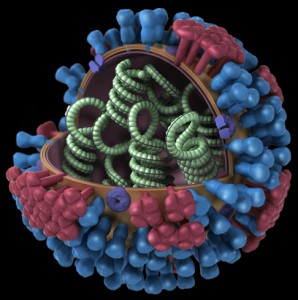Super flu and antibiotic abuse: no consistency on biosecurity


Perhaps you have heard about biomedical researchers discovering how to create a horrifically dangerous flu virus. Perhaps you have also heard about the authorities asking scientists to hush up parts of this discovery to keep it away from terrorists. Perhaps this news has reassured you about public safety in the face of biological threats.
It shouldn't. As a much lower-profile development last week involving antibiotics attests, what passes for national biosecurity policy is inconsistent, unreliable, and untethered from the pressing reality of the threats.
As has been widely reported, independent teams of biomedical researchers have recently gathered highly disturbing insights into how easily the H5N1 bird-flu virus could evolve into a human pandemic strain. H5N1 is the bird-flu strain that sparked a panic a few years ago when it caused several hundred human deaths. Fortunately, although H5N1 has a terrifying mortality rate of about 60 percent, the virus doesn't transmit efficiently among people (it usually requires extensive close contact even for transmission from birds to people), so it didn't become widespread.
But virology groups led by Ron Fouchier at the Erasmus Medical Center in the Netherlands and by Yoshihiro Kawaoka at the University of Wisconsin-Madison have been studying H5N1's potential for evolving to a more ominous form. They artificially infected ferrets with mutants of the virus, collected the most successful virus variants and emerged, and repeated the process for several generations. According to Fouchier, who discussed his results at a virology meeting in August, they produced a flu virus that moves easily through the air from ferret to ferret (and seems likely to be equally transmissible among humans) and has a high mortality rate.
(Researchers in the Influenza Division at the Centers for Disease Control and Prevention [CDC] also succeeded in artificially evolving H5N1 viruses that were more easily transmitted among mammals, as they described online in November in the journal Virology. The enhancement in transmission was smaller than Fouchier and Kawaoka's groups produced, however.)
Fouchier's group subsequently submitted a report on the work to the journal Science and Kawaoka sent one to Nature. But while the papers were under consideration, they came to the attention of the U.S. National Science Advisory Board for Biosecurity (NSABB), which offers federal guidance on biotechnologies that could represent threats to national defense or well-being. On Dec. 20 the NSABB -- which has no official regulatory authority -- urged the scientists and the journals to voluntarily redact important details from the papers before publication so that terrorists or other unfriendly powers couldn't use them to make a pandemic flu weapon.
What will a moratorium accomplish?
Fouchier, Kawaoka, and the editors of the journals eventually agreed to go along with the NSABB's request, but not without strong protest from many other scientists and parts of the concerned public. Some were fundamentally troubled by the idea of the government asking scientists to curtail their communications in the name of so slippery a value as national security: it smacked of censorship, even if it was ostensibly all voluntary. (Physicists and other specialists have of course restricted their speech for decades on previously classified work relevant to defense.) Others protested that the moratorium would be counterproductive because virologists might need the restricted information to develop better vaccines or other measures for preventing or fighting a pandemic influenza, should it either evolve naturally or be unleashed. The NSABB has said it will develop procedures for allowing appropriate scientists to see the full papers, but how that would work without compromising security is not yet clear.
Some experts have also questioned whether the moratorium could even protect the public as planned. Fouchier already presented his work in an open meeting, so much of the information would-be terrorists might need could already be floating around. In fact, just the knowledge that serial passage of H5N1 through ferrets can yield a pandemic-type virus, even in the absence of any specific experimental details, might be enough to encourage deeply committed terrorists -- assuming that any reckless, dumb, or suicidal enough to develop such a weaponized flu exist. And if the NSABB comes through with its plan to distribute details more widely, keeping the details secret will probably become only more futile.
Critics have also pointed out that the entire subject of the moratorium seems to distract from other questions that might be even more important to national security, such as whether influenza research this dangerous should be conducted at all (and who should do it) and why, if this kind of biomedical information represents a national threat, decisions about its confidentiality should reside with privately owned journals.
Notwithstanding the uncertainties and potentially unwanted consequences of the moratorium approach, one might at least take the consolation that it means the government is staunchly committed to putting the public's health and safety first. Unfortunately, another decision shows that to be not entirely true.
Wasting drugs in animal feed
Very quietly last week, the U.S. Food and Drug Administration (FDA) abandoned its 34-year-old strategy for banning the use of antibiotics as a routine supplement to animal feed. Since the 1950s, ranchers in the U.S. and other parts of the world have been adding small doses of penicillin and other antibiotics to their livestock's feed to boost meat production. The drugs help the animals put on weight more efficiently, perhaps by offsetting crowded, unsanitary farm conditions to some degree, although the doses are too small to be conventionally therapeutic.
Therein lies the problem: regularly exposing bacteria to sub-therapeutic doses of antibiotics is a recipe for breeding resistance. Almost since the practice began, scientists have worried that it might be contributing to the rapid rise of drug-resistant strains. In 1977, the FDA declared its intentions to hold hearings on the issue, but farming industry lobbying efforts in Congress forestalled them in favor of more research. The case against the use of antibiotics in feed may not be ironclad but evidence to that effect has continued to accumulate, including Institute of Medicine reports in 1988 and 2003, and a ban on antibiotic feed supplements in the European Union in 2006.
Yet three days before this past Christmas, in a move seemingly calculated to bury the news, the FDA published a note in the Federal Register that it was no longer interested in hearings. Although it acknowledged still having "safety concerns," the FDA said that for the immediate future, it would concentrate on "voluntary reform" by the agricultural industry. That shift is not encouraging: Maryn McKenna, a noted journalist who closely follows the drug-resistance problem, observes that the FDA's 2010 draft guidelines for reform are still unfinished and vehemently opposed by farming interests.
Bear in mind that multi-drug resistant Staphylococcus aureus (MRSA) infections alone kill more than 18,000 hospitalized people in the U.S., according to one 2007 study by the CDC. This past April, the Translational Genomics Research Institute announced that it had found drug-resistant staph bacteria in 47 percent of the commercially sold meat in five U.S. cities. And those figures are for just one type of bacteria in one country: the World Health Organization estimates that drug-resistant tuberculosis kills more than 150,000 people globally every year.
It makes no sense that the U.S. government should be pushing for extraordinary and controversial controls over research to prevent bioterrorism -- a threat that is unrealized and perhaps unlikely -- while also taking a regressive, business-as-usual approach to a menace that kills huge numbers of people every year. True, different agencies and departments within the government are setting these policies, but maybe that is part of the problem. If preventing antibiotic resistance were part of a better-coordinated strategy for protecting the U.S. from both natural and malicious biological threats, then the rank unacceptability of wasting the drugs in animal feed would be obvious.
•
Related on SmartPlanet:
Government asks journals to censor details of deadly flu virus, by Laura Shin
This post was originally published on Smartplanet.com